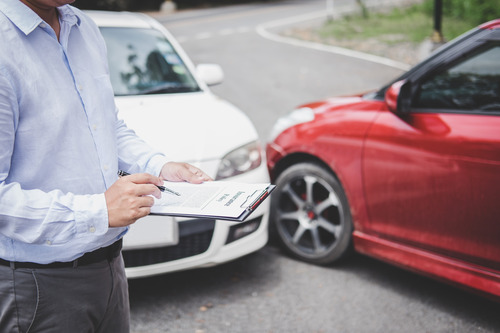At Mogy Law, we are dedicated to providing personalized and compassionate legal support to clients in Raleigh and across North Carolina. With extensive experience handling car accident and personal injury claims, our team works tirelessly to ensure you receive the compensation you deserve. We understand the stress that comes with an accident, and we are committed to guiding you through every step of the legal process.
Proving fault in a car accident is essential for securing the compensation you deserve, especially in North Carolina, where the law follows a contributory negligence rule. If you are injured in a crash, you must know how to prove fault of the other driver in order to recover for medical expenses, property damage, and other losses.
In this blog, we will explore how to prove fault of another party in a car accident, including steps to gather crucial evidence, handle insurance claims, and the importance of working with an experienced Raleigh car accident attorney to strengthen your case and secure the compensation you deserve.
Understanding North Carolina’s Fault Laws
In North Carolina, knowing how to prove fault in a car accident is essential to recovering compensation. The state’s laws can be complex, especially when it comes to determining who is liable for an accident.
Contributory Negligence in North Carolina
North Carolina follows a pure contributory negligence rule. This means that if you are found to be even 1% at fault in the accident, you cannot recover compensation for your car accident claim. This law makes proving fault crucial in a car accident case. For example, if a driver runs a red light but you were speeding at the time, your ability to recover compensation may be affected if the court finds you partially negligent.
Impact on Your Car Accident Claim
Since contributory negligence bars recovery if you share any fault, it is vital to establish that the other driver was entirely responsible. If you are involved in a car accident, the police report and accident report will help determine which driver is at fault. A strong case relies on evidence such as witness testimony, vehicle damage, and physical evidence to prove that the other driver’s actions were the primary cause of the crash.
How to Prove Fault in a Car Accident Case
In many cases, proving fault involves showing that the other driver’s negligent behavior led directly to the accident. This can be done through a variety of means, including an independent investigation and expert testimony. Police reports often provide initial details on fault, but other forms of evidence, like skid marks or vehicle damage, are also important to prove liability. Understanding these details is key to ensuring that your injury is recognized as caused by the other party’s actions.
Steps to Gather Evidence at the Accident Scene
Collecting evidence at the scene of a car accident is crucial for proving fault and building your case. Proper evidence can support your claim and help demonstrate the other driver’s responsibility.
Call the Police and File a Report
The first step after any car accident should be to call the police. Having a police report filed creates an official record of the event, which can serve as vital evidence. This report often includes important details such as the cause of the accident, vehicle damage, and the officer’s assessment of fault. Always request a copy of the accident report and review it for accuracy.
Take Photos and Videos of the Scene
Photographs and videos are powerful tools for gathering evidence. Capture images of vehicle damage, skid marks, road conditions, and traffic signals such as stop signs or red lights. These photos provide a visual record of the accident scene and can help demonstrate key factors, such as whether the other driver ran a stop sign or failed to yield. Additionally, videos from a dashcam or nearby security cameras can offer undeniable proof of how the crash occurred.
Collect Witness Information
Eyewitnesses can play a critical role in establishing fault. If possible, ask any witnesses to provide their contact information and a statement about what they saw. Witness testimony can corroborate your version of events and strengthen your case. Having multiple independent accounts of the incident helps support the claim that the other driver was at fault.
Document Details of the Accident
Write down any important details about the accident that may not be immediately obvious. For example, note the speed limit in the area, the time of day, weather conditions, and the behavior of the other driver (such as signs of distracted driving or speeding). The more specifics you can provide, the stronger your case will be in proving negligence.
Look for Physical Evidence
Physical evidence at the accident scene, such as debris or damaged road signs, can further support your claim. Additionally, looking for signs of the other driver’s behavior, like vehicle damage that suggests negligent driving (e.g., hitting the curb or colliding with objects), can help establish that they were at fault. If possible, take pictures of any skid marks left behind, as these can be used to analyze the speed and braking patterns involved in the crash.
Dealing with Insurance Companies and Proving Fault in a Claim
After an accident, dealing with insurance companies can be challenging. Proving fault and securing the compensation you deserve requires careful handling of your car accident claim.
Understand the Insurance Company’s Tactics
Insurance companies are focused on minimizing their payouts. They may try to shift some of the responsibility for the accident onto you, even if you aren’t at fault. This is why it’s crucial to avoid admitting any fault at the scene or during your conversations with the insurer. Let your legal team guide you through the process to prevent insurance companies from taking advantage of you.
Provide Clear Evidence of Fault
To prove that the other driver is liable, you must present clear evidence. This includes police reports, witness statements, photos of vehicle damage, and traffic citations (such as a ticket for running a red light). The more evidence you have, the harder it is for the insurance company to argue against your version of events. Documentation of your medical expenses and the extent of your injury is also necessary to show the full impact of the accident.
Avoid Settling Too Quickly
Insurance adjusters may offer a quick settlement, hoping to resolve the case cheaply. Don’t rush to accept an offer without consulting your attorney. The first offer may not cover all of your property damage and medical expenses. By fully understanding the value of your claim, your legal team can negotiate for a better settlement that reflects the true cost of your injuries and losses.
Independent Investigation to Strengthen Your Claim
An independent investigation into the accident can help clarify the cause and strengthen your case. Your attorney may hire accident reconstruction experts to analyze evidence like vehicle damage and skid marks. This investigation can confirm that the other driver was at fault, ensuring your case is supported by facts that prove negligence.
When to Hire a North Carolina Car Accident Attorney
Hiring a North Carolina car accident attorney can make a significant difference in the outcome of your car accident claim. Knowing when to get legal help can ensure your rights are protected and your case is handled properly.
After an Accident Involving Serious Injury or Property Damage
If you’ve been involved in a car accident that results in serious injury or significant property damage, it’s important to consult with an attorney right away. The complexity of such cases often requires professional legal expertise to ensure proper evidence is gathered and fault is established. In these situations, an attorney can help navigate the medical expenses, vehicle replacement costs, and the long-term effects of the injury.
When You Face Disputes Over Fault
In cases where determining fault is contested, it’s essential to have an experienced attorney by your side. Insurance companies may try to shift liability, or you might face allegations of being partially negligent. A North Carolina car accident lawyer can help build a strong case using witness testimony, physical evidence, and expert opinions. This is particularly important in contributory negligence states like North Carolina, where even a small amount of fault can prevent you from recovering damages.
If Insurance Companies Are Offering Low Settlements
Insurance companies may try to offer you a quick, low settlement, hoping to avoid a larger payout. If you feel that the offer doesn’t cover your medical expenses or property damage, you should consult a lawyer. A skilled attorney can assess the full value of your claim and negotiate with the insurance company to ensure you receive fair compensation. Don’t accept any settlement without understanding your full rights.
How Mogy Law Can Help
At Mogy Law, we understand the challenges that come with recovering from a car accident. Our experienced legal team is ready to help you gather evidence, negotiate with insurance companies, and build a strong case to prove fault. We offer free consultations, so you can discuss your case without any financial commitment. With a proven track record of successful car accident claims, we are dedicated to helping clients in Raleigh and across North Carolina recover the compensation they deserve.
Contact an Experienced Raleigh Car Accident Lawyer Today!
If you’ve been involved in a car accident and need help on how to prove fault, our team at Mogy Law is here to support you every step of the way. We understand the complexities of North Carolina’s fault laws and the challenges that come with dealing with insurance companies.
Contact us at (901) 443-9133 for a free case review today!







